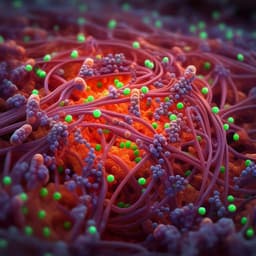
Chemistry
Design of a gold clustering site in an engineered apo-ferritin cage
C. Lu, B. Maity, et al.
Discover the innovative engineering behind a unique gold clustering site within the apo-ferritin cage, capable of holding up to 12 gold atoms! This groundbreaking research, conducted by Chenlin Lu, Basudev Maity, Xue Peng, Nozomi Ito, Satoshi Abe, Xiang Sheng, Takafumi Ueno, and Diannan Lu, unveils the intricate role of amino acids in gold ion accumulation and cluster formation.
Playback language: English
Introduction
Water-soluble and biocompatible protein-protected gold nanoclusters (Au NCs) are promising materials for various applications. However, precise control over their atomic-level structure remains a significant challenge. This study addresses this challenge by designing and constructing a specific gold clustering site within the well-defined cavity of an apo-ferritin protein cage. Apo-ferritins, naturally occurring protein nanocages, provide a biocompatible and well-characterized scaffold for the controlled assembly of inorganic materials. Their internal cavities offer a confined environment suitable for precise control of nanoparticle synthesis. The researchers hypothesized that by strategically modifying the apo-ferritin's amino acid sequence, they could create a binding site with a high affinity for gold ions, leading to the formation of a well-defined gold nanocluster within the protein cage. This approach offers several advantages over traditional methods for synthesizing gold nanoclusters, which often result in heterogeneous populations with varying sizes and shapes. Precisely controlling the structure of gold nanoclusters is crucial because their properties (optical, catalytic, etc.) are highly dependent on their size and shape. The ability to engineer a specific binding site within a protein cage allows for a higher degree of control, leading to more uniform and predictable nanocluster properties. This precise control has significant implications for various applications, including catalysis, sensing, and biomedicine. The introduction also emphasizes the need for detailed structural characterization to fully understand the formation and properties of the engineered gold nanoclusters. X-ray crystallography will provide high-resolution structural information on the gold cluster within the protein cage, while quantum chemical calculations will shed light on the electronic structure and bonding interactions within the cluster.
Literature Review
The paper extensively reviews the literature on protein-protected gold nanoclusters, highlighting their potential applications and the challenges associated with controlling their structure at the atomic level. It cites numerous studies focusing on the synthesis, characterization, and catalytic applications of gold nanoclusters. The literature review covers the use of different proteins, including those found in nature, for the stabilization of gold nanoclusters. The review also touches upon the use of various techniques, such as X-ray crystallography and computational methods, for characterizing the structure and properties of gold nanoclusters. The authors highlight previous work on metal ion incorporation into ferritin cages, demonstrating the use of this protein as a nanoreactor for controlling the synthesis of inorganic materials. This body of work provided a foundation for the current study, demonstrating the feasibility of using a protein cage to synthesize metal nanoclusters with defined properties and structure. Specific studies on apo-ferritin-based nanoreactors are highlighted, providing a contextual basis for the current experimental approach. The use of site-directed mutagenesis to modify the interior of the ferritin cage to create specific binding sites for metal ions is also reviewed.
Methodology
The study employed a multi-pronged methodology combining protein engineering, synthetic chemistry, advanced structural characterization, and quantum chemical calculations. The researchers first engineered a mutant apo-ferritin (rHLFr) by introducing specific mutations (R168H/L169C) at the 4-fold symmetric axis channel. This modification aimed to create a high-affinity binding site for gold(I) ions. The modified protein was then reacted with varying equivalents of chloro(dimethylsulfide)gold(I) (Me2SAuCl), a gold precursor. After purification, the resultant Au-apo-ferritin complexes were analyzed using various techniques. Inductively Coupled Plasma Mass Spectrometry (ICP-MS) coupled with a Bicinchoninic Acid Assay (BCA) was utilized to quantitatively determine the number of gold atoms bound to the protein. X-ray Photoelectron Spectroscopy (XPS) determined the oxidation state of the gold ions in the complexes. X-ray crystallography was the core method for obtaining the high-resolution 3D structures of the Au-apo-ferritin complexes at different gold concentrations. These analyses determined the location, coordination, and number of gold atoms within the engineered cavity. Multiple wavelengths (1.15 Å and 1.00 Å) were used for the anomalous scattering in the structure determination. The hanging-drop vapor diffusion method was used for crystal growth. The structures were refined using REFMAC5 and modeled using COOT, with water molecules added based on residual electron density. Anomalous electron density maps were utilized to locate the gold atoms, differentiating them from other metals like cadmium (Cd) which was used in the precipitant solution for crystallization. Quantum Chemical (QC) calculations, using the Gaussian 16 software package with the PBE0 hybrid density functional method, provided further insights into the electronic structure, bonding interactions, and stability of the gold clusters. The basis sets used in calculations were 6-311G(d) for C, N, S, H, and Stuttgart/Dresden (SDD) for Au. D3-BJ empirical method was applied to account for dispersion forces. The ADCH (Atomic Dipole moment corrected Hirshfeld) charge analysis and MCBO (Multi-center bond order) analysis with Multiwfn software were performed to study the electronic properties of the gold clusters. UV-Vis and EEM spectroscopy were performed to characterize the optical properties of the gold nanoclusters, focusing on the absence of emission in the Au(I) clusters, consistent with literature reports on similar systems.
Key Findings
The study's key findings revolve around the successful design and characterization of a novel gold clustering site within the apo-ferritin cage. X-ray crystal structures revealed that up to 12 gold atoms could be accommodated in the engineered cavity, forming a multinuclear gold cluster. The number of gold atoms in the cluster could be precisely tuned by varying the concentration of the gold precursor. At lower concentrations (50 equiv), 8 gold atom positions were observed, while at higher concentrations (400 equiv), 12 positions were occupied, showing a structural rearrangement. Analysis of the crystal structures revealed four key binding sites for gold ions: a 3-fold site, a Cys48 site, a Met96 site, and the engineered 4-fold site. The binding affinity order was determined as 3-fold > 4-fold >= Cys48 >> Met96, with the 3-fold site being the primary entry point for gold ions. The authors observed that the Au ions entered the cage through the 3-fold channels and then migrated to the other binding sites, notably the engineered 4-fold channel. The stepwise increase in gold precursor concentration allowed the observation of conformational changes in key amino acid residues (Glu45, His49, Arg52, and Glu130) involved in gold ion accumulation and cluster formation. The crucial role of the mutated residue R168H in stabilizing the gold clusters and mediating its structural transformation at higher Au concentrations is highlighted. The R168H residue was shown to dynamically change its conformation during this process, interacting with the gold atoms. Quantum chemical (QC) calculations confirmed the formation of a stable gold cluster through multi-center bonding interactions. ADCH charge analysis revealed a unique charge distribution in the cluster, with some Au atoms exhibiting positive charges and others negative charges. MCBO analysis confirmed multiple multi-center interactions within the gold cluster, reflecting the unusual bonding pattern of the multinuclear complex. UV-Vis and EEM spectroscopy showed that the generated Au(I) clusters were non-emissive, consistent with previously reported emissive gold clusters containing Au(0) rather than Au(I).
Discussion
The results demonstrate the feasibility of precisely designing and controlling the structure of gold nanoclusters using protein engineering and a well-defined protein scaffold. The ability to precisely tune the number of gold atoms in the cluster by simply adjusting the precursor concentration underscores the strength of this approach. The findings are relevant to both fundamental research in nanomaterials science and applications in areas such as catalysis and biomedicine. The ability to create uniform and well-defined gold nanoclusters opens the possibility of investigating their properties in detail and exploiting them for specific applications. The observed dynamic behavior of certain amino acid residues during gold accumulation highlights the importance of considering protein flexibility in the design of protein-based nanoreactors. The combination of experimental data from X-ray crystallography and computational analysis provides a comprehensive understanding of the formation and stability of the gold clusters. The non-emissive nature of the Au(I) clusters suggests further exploration of the relationship between oxidation state and optical properties is warranted. The specific binding motifs revealed in this study also provide insights into the design of similar systems with other metals and ligands.
Conclusion
This study successfully engineered a highly specific and tunable gold clustering site within an apo-ferritin cage, demonstrating precise control over the size and structure of a gold nanocluster at the atomic level. The findings highlight the potential of protein engineering to overcome the challenges associated with the synthesis of uniform gold nanoclusters, paving the way for designing precisely tailored nanoclusters with specific properties for various applications. Future research could explore the use of this platform for creating other metal nanoclusters, investigating the catalytic properties of the engineered gold clusters, and exploring different protein scaffolds for this type of controlled nanocluster synthesis.
Limitations
While the study provides valuable insights into the formation and structure of gold nanoclusters within the apo-ferritin cage, some limitations should be acknowledged. The study primarily focuses on gold(I) clusters, and its findings may not directly translate to other oxidation states of gold or other metals. The quantitative analysis using ICP-MS/BCA showed discrepancies with the number of gold atoms determined by X-ray crystallography, potentially due to non-specific binding or limitations in detecting all gold atoms in the crystal structure. The residual electron density in the 4-fold channel, even after assigning the major Au positions, remains unassigned and could potentially affect the interpretation of the cluster structure. Future work should aim to address these limitations for a more comprehensive understanding of the system.
Related Publications
Explore these studies to deepen your understanding of the subject.







